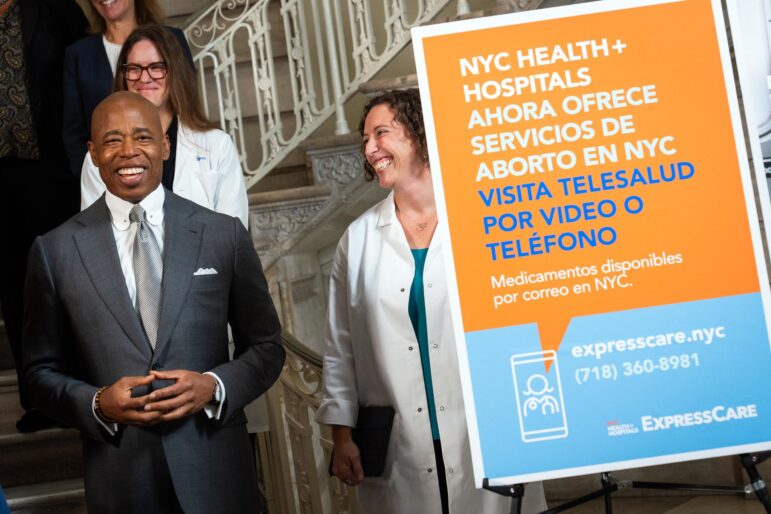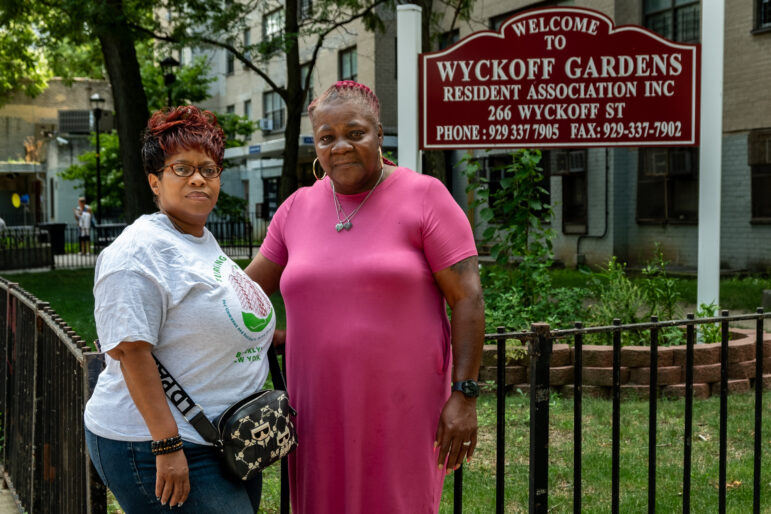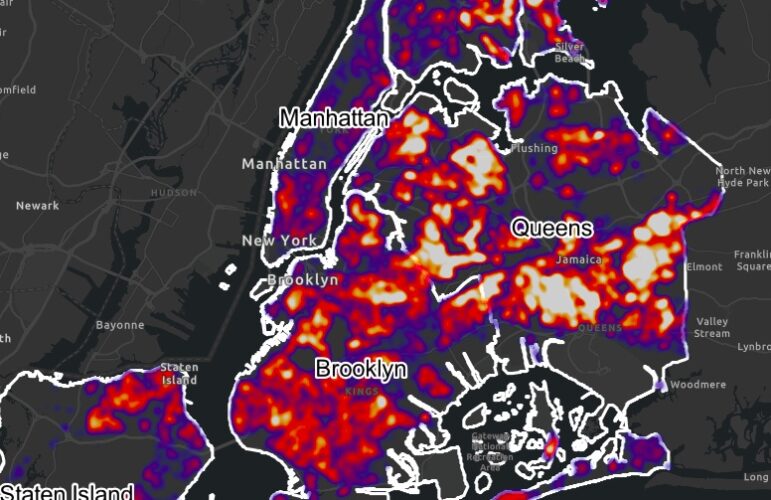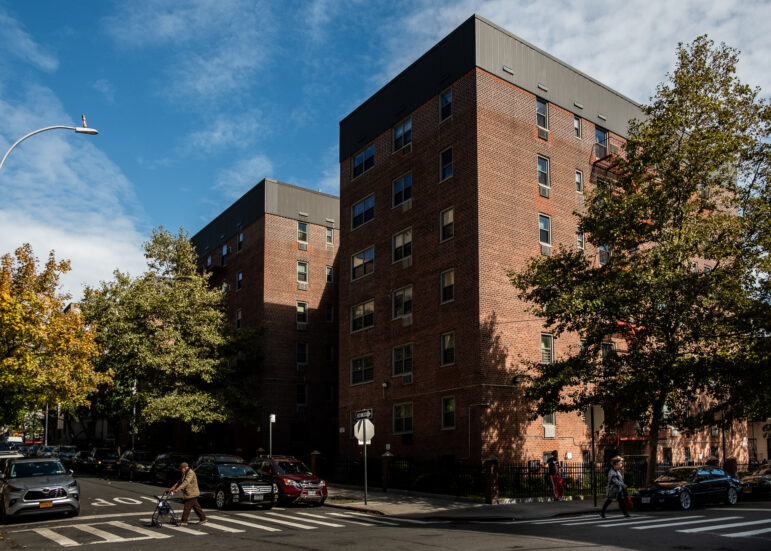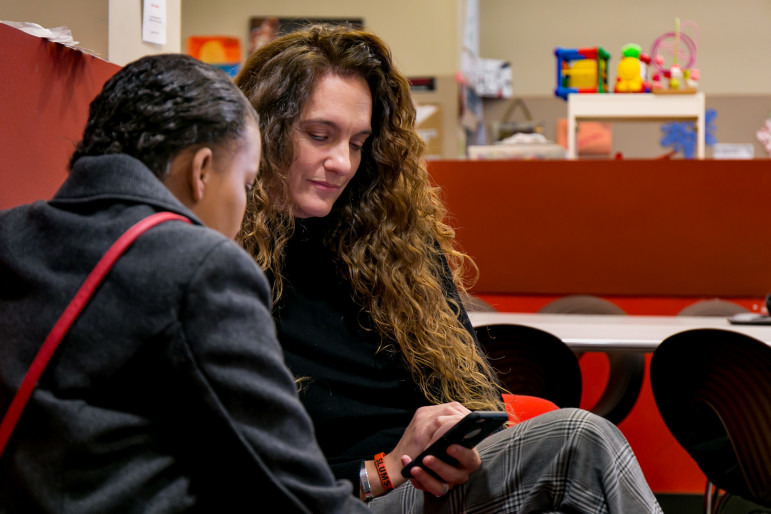
Adi Talwar
Julie Laurence, Chief Program Officer at Girls Educational & Mentoring Services (GEMS) with one of their members at their drop-in center.
Turning 21 is a milestone with a different meaning for a homeless youth in New York. When that day arrives, he or she usually must leave the city’s youth shelter system, and they also lose many essential services. If they haven’t found permanent housing on their own, they are forced back out onto the street. They can go into the large adult shelter system, but most youth don’t feel safe mixed into the general adult population. Yet the city’s supportive housing and the new LINC housing program are accessible only through shelters, meaning young people can miss out.
“The youth population is not provided with anywhere near enough resources to prevent them from becoming chronically homeless adults,” says Craig Hughes, Assistant Director of Resource Counseling at Safe Horizon’s Streetwork Project. “Without access to housing subsidies provided by the City, as well as resources such as public housing and consistent access to supportive housing, far too many homeless young people are at significant risk for violence, abuse and exploitation.”
A coalition of youth shelter and drop-in agencies have been speaking with New York City officials regarding these concerns, says Hughes, and they’re asking for a special “fast track” to be created to address them.
There are reportedly 58,000 people sheltered nightly in the Department of Homeless Services (DHS) adult shelter system this year. In the Department of Youth & Community Development (DYCD) shelter system there are presently about 453 beds. While older youth can legally access those beds, homeless people 20 and younger get priority and there are rarely leftovers. There are three separate locations that offer drop-in services and shelter for 21-24 year olds, the Ali Forney Center, Safe Horizon’s Streetwork Project, and Covenant House. But the system is a patchwork at best.
Facing special challenges
It’s very difficult to get an accurate count of homeless youth but the prevailing official count—based on a 2007 study—is 1,750 street-homeless youth per night in NYC, and 3,800 homeless youth overall.
The larger number includes youth that are unstably housed, in shelters, jail and other facilities. “There have been other counts since then but nothing that comes as close to capturing the true scope of the problem,” says Jamie Powlovich, residential director of GEMS, an educational and mentoring center for girls and young women “who have experienced commercial sexual exploitation and domestic trafficking.”
In the current housing market it’s tough for anyone in the lower economic bracket, even with careers, to get and maintain housing, much less a young person working a minimum wage job, or unemployed and dealing with mental health issues without any family back up. Since funding cuts were made during the Bloomberg years, youth advocates across the city have been making desperate appeals to the city and state policy makers, and they are amplifying those calls now as Mayor de Blasio is midway through a comprehensive, 90-day review of the city’s homeless crisis.
Advocates agree that the mayor has made strides since he took office toward addressing the homeless crisis. Most notable is the roll out of LINC, a set of housing voucher programs for different populations to help homeless families and adults to exit the shelter system into permanent housing. The program prioritizes victims of domestic violence and families with children, and the elderly. They’ve successfully moved 22,000 people out of the shelter system since 2014.
For 21-24 year olds to attempt to access housing subsidies, they must enter the DHS system to be eligible, and then they are placed on a waitlist, but that wait can be years. What’s more, many young homeless adults express fears of being mixed in among the general adult population. Some estimate that as many as 60 percent of the youth homeless are LGBTQ-identified. These young people are often the target of bullying and harassment—in fact, those are the reasons that caused many of them to run away or and be rejected by their families in the first place, says Carl Siciliano, executive director of the Ali Forney Center, a center that focuses specifically on the needs of homeless LGBTQ youth.
They are so fearful that they opt to sleep in the streets or in the subways rather than in the large shelter system. They resort to “survival sex and other illegal activities in order to survive, frequently resulting in HIV infection, drug addiction and criminalization,” says Siciliano.
New science on youth development
For this reason, advocates would also like to see the youth fast tracked into supportive housing, bypassing the DHS shelter system altogether.
“Many of the youth are traumatized and suffer from disabilities,” says Beth Hofmeister, a staff attorney at The Legal Aid Society, Homeless Rights Project. Hofmeister and her colleague Kimberly Forte, Supervising Attorney of The Legal Aid Society’s LGBTQ Law and Policy Initiative, explain that in the youth shelter, there is the expectation that a youth can get their life together and find housing in one to two months, but that’s an extremely difficult feat.
Youth are allowed to stay in the DYCD shelters 60 days with an extension of 30 days, with the possibility to re-enroll, but the attorneys say young people can wait up until a month for an evaluation and often go without mental health services because of insufficient funding, and they have to be sent out for services. “Just getting their birth certificate and other paper work can easily take a month or two,” says Hofmeister. “We all know, the city, advocates, and society knows, she says that these kids have suffered traumatic histories and yet we expect them to function at a high level.”
Advocates also say city policies should reflect new research about the mental capacity of young people. “The science is clear that adolescence lasts until the early twenties and the city should rely on this science when providing services,” says Forte. “Once young adults are placed in the general adult shelter system, they think of themselves as homeless adults and rely on services that are not likely to be a success for them. Youth homelessness is caused by very different reasons than adult homeless, for example: family rejection and juvenile justice and foster care systems failure.”
The expectation that this age group are developmentally ready to be on their own is being challenged on many levels, according to Sarah Meckler, Assistant Director of Special Populations at The Door: Research indicates that development of a young person is now thought to continue up to age 25, “especially considering the complex trauma that most homeless youth face as they grow up, [and it may not be reasonable] that they are expected to be able to function independently at the age of 21,” she says.
Those youth who do manage to stay in the municipal shelters system may go through the process to qualify for supportive housing, but “the young person may not be chosen for an apartment by a given provider. And NYCHA (public housing), the waitlist can be many years,” says Hughes.
Wanted: Beds and a bypass
While advocates would also like to see priority access for 21-24 years to voucher subsidies, they’d also like to see an increase in numbers of beds for this age range within the DYCD system. Currently, there are never any vacancies in any of the shelters and hundreds of youth are turned away every day. In January, de Blasio announced the addition of 300 beds for 16-20 years olds bringing the total of beds to 753 by year 2019.
De Blasio said at a press conference in January that the city would keep adding beds, until they were seeing no vacancies, which would tell them that no homeless youth was turned away: “We don’t want any young person waiting. Those days have to end in this city. Every one of our young people needs a safe and secure place where they can sleep at night away from the dangers of our streets.”
But there has been no corresponding announcement for extending DYCD services for the 21-24 age range and including them in supportive housing or the LINC program.
“Government officials know the issues are there. Their choice to do something to resolve these crises is up to them,” says Hughes.
Asked to comment for this article, Dayana Perez, deputy press secretary at DYCD told City Limits in a statement: “We appreciate the confidence that service providers have in DYCD, and remain focused on providing support so we can help vulnerable young people stabilize their lives.”



